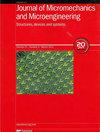A penetration efficiency model for the optimization of solid conical microneedles’ geometry
IF 2.4
4区 工程技术
Q2 ENGINEERING, ELECTRICAL & ELECTRONIC
引用次数: 0
Abstract
Microneedles (MNs) are promising alternatives to pills and traditional needles as drug delivery systems due to their fast, localized, and relatively less painful administration. Filling a knowledge gap, this study investigated and optimized the most influential geometrical factors determining the penetration efficiency of MNs. The effects of height, base diameter, and tip diameter were analyzed using the finite element method, with results showing that the most influencing factor was base diameter, followed by height. Moreover, the taper angle, which is dependent on all the geometrical factors, was found to directly affect the penetration efficiency at a fixed height. An additional model was developed to relate the height and taper angle to penetration efficiency, and the results were experimentally validated by compression testing of MN array prototypes printed using two-photon photolithography. The numerical model closely predicted the experimental results, with a root mean square error of 9.35. The results of our study have the potential to aid the design of high-penetration efficiency MNs for better functionality and applicability.用于优化固体锥形微针几何形状的穿透效率模型
微针(MNs)是药丸和传统针头给药系统的替代品,因其给药速度快、局部性强且相对痛苦较少而大有可为。本研究填补了这一知识空白,调查并优化了决定微针穿透效率的最有影响力的几何因素。研究采用有限元法分析了高度、基底直径和尖端直径的影响,结果表明影响最大的因素是基底直径,其次是高度。此外,还发现锥角直接影响固定高度下的穿透效率,而锥角取决于所有几何因素。通过对使用双光子光刻技术打印的 MN 阵列原型进行压缩测试,对结果进行了实验验证。数值模型对实验结果的预测非常接近,均方根误差为 9.35。我们的研究结果有望帮助设计出高穿透效率的 MN,从而提高其功能性和适用性。
本文章由计算机程序翻译,如有差异,请以英文原文为准。
求助全文
约1分钟内获得全文
求助全文
来源期刊

Journal of Micromechanics and Microengineering
工程技术-材料科学:综合
CiteScore
4.50
自引率
4.30%
发文量
136
审稿时长
2.8 months
期刊介绍:
Journal of Micromechanics and Microengineering (JMM) primarily covers experimental work, however relevant modelling papers are considered where supported by experimental data.
The journal is focussed on all aspects of:
-nano- and micro- mechanical systems
-nano- and micro- electomechanical systems
-nano- and micro- electrical and mechatronic systems
-nano- and micro- engineering
-nano- and micro- scale science
Please note that we do not publish materials papers with no obvious application or link to nano- or micro-engineering.
Below are some examples of the topics that are included within the scope of the journal:
-MEMS and NEMS:
Including sensors, optical MEMS/NEMS, RF MEMS/NEMS, etc.
-Fabrication techniques and manufacturing:
Including micromachining, etching, lithography, deposition, patterning, self-assembly, 3d printing, inkjet printing.
-Packaging and Integration technologies.
-Materials, testing, and reliability.
-Micro- and nano-fluidics:
Including optofluidics, acoustofluidics, droplets, microreactors, organ-on-a-chip.
-Lab-on-a-chip and micro- and nano-total analysis systems.
-Biomedical systems and devices:
Including bio MEMS, biosensors, assays, organ-on-a-chip, drug delivery, cells, biointerfaces.
-Energy and power:
Including power MEMS/NEMS, energy harvesters, actuators, microbatteries.
-Electronics:
Including flexible electronics, wearable electronics, interface electronics.
-Optical systems.
-Robotics.
 求助内容:
求助内容: 应助结果提醒方式:
应助结果提醒方式:


